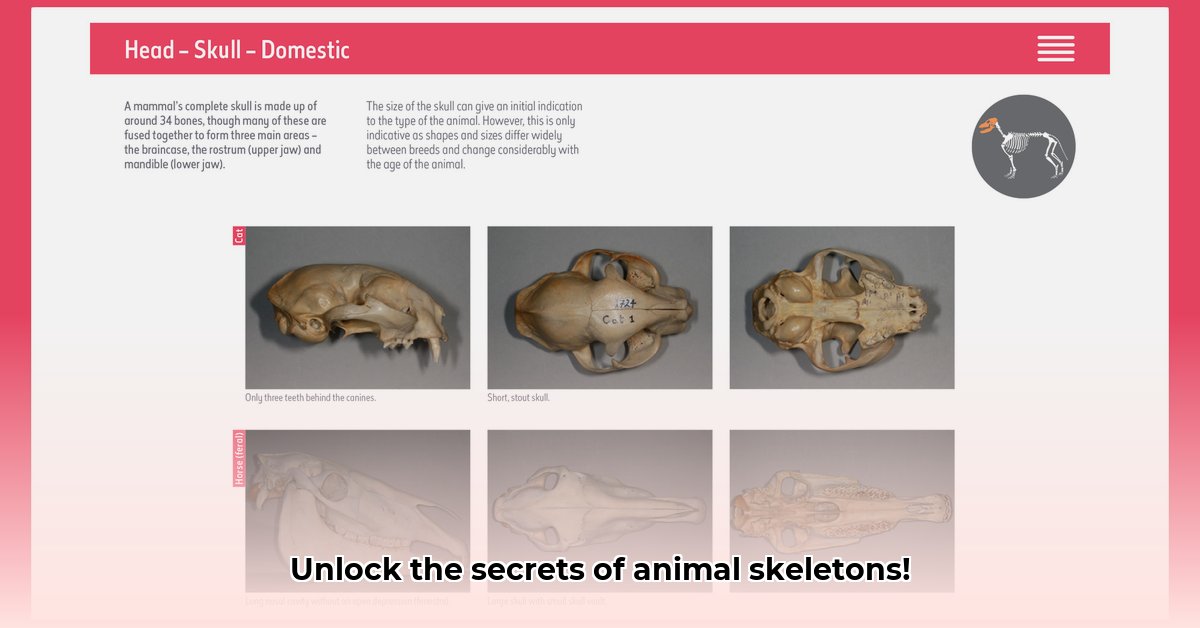
Identifying animal skeletons, whether for wildlife research, forensic investigation, or personal enrichment, requires reliable resources. This review compares two prominent online guides—BoneID.net and WakingUpWild—to help you select the best tool for your needs. We'll analyze their strengths and weaknesses, offer practical advice, and address potential challenges in using online resources for skeletal identification. For additional resources, check out this helpful guide: Animal Skeleton Guide.
BoneID.net: A Comprehensive Database for Experienced Users
BoneID.net functions as a vast, searchable database, ideal for precise skeletal identification. Its strength lies in its comprehensive collection of detailed skeletal data across numerous species. Think of it as a highly specialized search engine for bone characteristics. However, its complexity requires a foundational understanding of skeletal anatomy, making it less suitable for beginners.
Pros:
- Extensive Species Coverage: BoneID.net boasts an impressive range of animal skeletal data.
- Precise Search Functionality: Its powerful search tools enable targeted searches based on specific bone features.
- Ongoing Development: The database is continuously updated, ensuring accuracy and expanding its coverage.
Cons:
- Steep Learning Curve: Navigating the database requires prior knowledge of skeletal anatomy and terminology.
- Complex Interface: The depth of information can lead to a complex user experience, posing a challenge for novices.
WakingUpWild's Animal Skull Identification Guide: A Visual Approach for Beginners
WakingUpWild adopts a more visual and intuitive approach, prioritizing clear images and comparisons. This makes it an excellent starting point for those new to animal skeleton identification. It's akin to using a well-illustrated field guide, focusing on visual learning. However, its reliance on visual comparisons might limit its precision when dealing with closely related species.
Pros:
- User-Friendly Interface: The visual format simplifies learning, making it accessible to beginners.
- Intuitive Design: The emphasis on visual comparisons facilitates understanding key skeletal features.
- Easy to Grasp Basics: Perfect for introductory learning about animal skulls.
Cons:
- Limited Precision: Distinguishing closely related species might prove difficult due to its visual-only approach.
- Narrower Species Scope: Its coverage likely encompasses fewer species compared to the broader reach of BoneID.net.
Choosing the Right Guide: A Tailored Approach
The ideal resource depends on your experience and objectives. BoneID.net's detailed approach empowers professionals and experienced enthusiasts requiring precise identification. Its comprehensive data makes it a robust tool for in-depth analysis. Conversely, WakingUpWild serves as an effective introduction for beginners, offering a user-friendly learning experience. Both emphasize the importance of expert verification when uncertainties arise. What are your specific needs when choosing an online guide?
Actionable Steps for Different User Groups
The following table outlines effective strategies for various user groups:
| Stakeholder Group | Short-Term Application | Long-Term Strategies |
|---|---|---|
| Forensic Anthropologists | Integrate BoneID.net into case analysis workflows. | Contribute to database improvements and expansion. |
| Law Enforcement | Use BoneID.net for preliminary identification. | Incorporate digital resources into training programs. |
| Educators/Researchers | Utilize both resources for comparative analyses. | Develop standardized digital identification protocols. |
| Wildlife Enthusiasts | Employ WakingUpWild's guide for field observations. | Contribute field data and images to resources like BoneID.net. |
| Museum Curators | Use both as educational tools and for collection management. | Collaborate on integrating museum collections into digital databases. |
Minimizing Risks: Addressing Potential Challenges
While these online resources are valuable, they have limitations. Inaccurate data, incomplete information, and the risk of misidentification are inherent. To mitigate these risks:
- Critical Evaluation: Always critically assess the provided information.
- Cross-Referencing: Verify findings using multiple sources.
- Expert Consultation: Consult experts when required.
Remember, the possibility of errors exists; exercise caution when employing these or any digital resources. How often do you verify information from online resources?
Enhancing Accuracy: Practical Tips and Considerations
Improving the accuracy of online animal skull identification hinges on selecting reliable resources and honing your skills.
Selecting High-Quality Guides:
- Image Quality: Prioritize high-resolution images with multiple views.
- Species Representation: Choose resources with broad species coverage and relevant geographic information.
- Measurement Data: Look for guides providing precise measurements.
- Expert Verification: Ensure the guide has been reviewed by experts in the field.
- User Feedback: Consider user reviews to evaluate accuracy and usability.
- Data Updates: Select resources that are regularly updated to reflect current scientific knowledge.
Improving Identification Skills:
- Master Fundamentals: Learn basic skull anatomy and terminology.
- Compare and Contrast: Practice comparing skulls side-by-side.
- Focus on Key Features: Concentrate on distinguishing characteristics.
- Utilize Multiple Resources: Cross-reference findings from several reputable sources.
- Document Findings: Meticulously record your identifications, including images and measurements.
- Seek Feedback: Share your identifications with experienced individuals for review.
Addressing common pitfalls like incomplete specimens, juvenile skulls, geographic variations, and individual variation is also crucial for accurate identification.
Conclusion: Embarking on Your Skeletal Identification Journey
The world of animal skeleton identification is rich and rewarding. Selecting the appropriate online resource significantly impacts your success. BoneID.net offers the precision needed for advanced studies, while WakingUpWild provides a user-friendly entry point. Remember to approach this field with a critical and questioning mindset, always striving for verification and continuous learning.